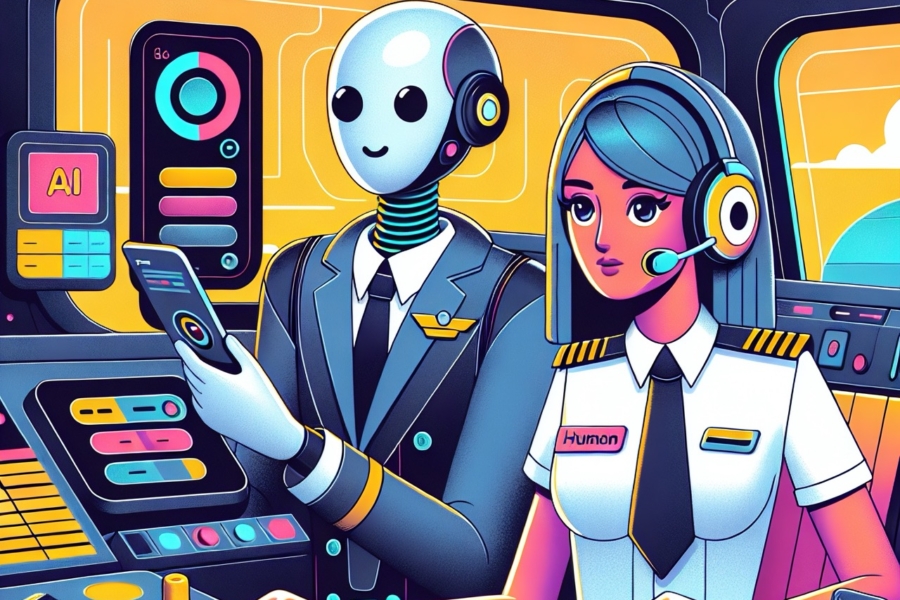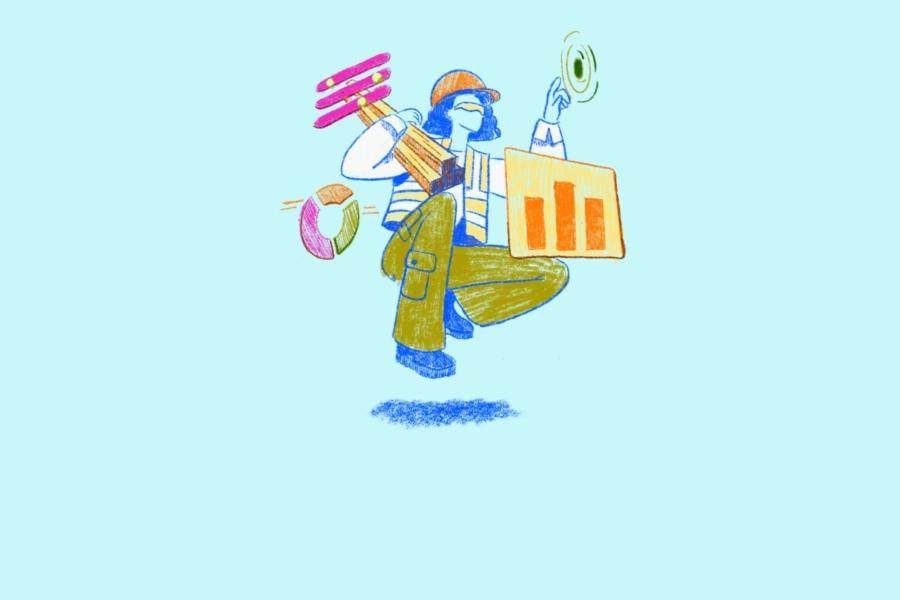Since the release of ChatGPT, there has been no shortage of AI “co-pilots” promising to take routine and mundane tasks off our plates to let us focus on the tasks that are uniquely human. We’ve seen them emerge in a range of sectors, across education, engineering, sales, law, and more.
So this made us ask: what does this mean for workers?
As we documented in ReimagineWork, employers in a post-AI world will need tools to help them understand, at any given moment, the skills they need to hit their business objectives, the skills their workforce has, and the pathways to help close that gap. For workers, this means that they will need to learn how to work in collaboration with AI and build a continuous upskilling mentality to develop and refine the skills that AI is not able to take on.
It is very easy to fall into the doom-and-gloom trap of believing that AI will render jobs obsolete. The reality is a lot more nuanced. While AI will automate many tasks that humans are currently doing, it will ultimately allow us to focus on things that require human judgment, instincts, and perspectives to complete.
The concept of a co-pilot in a traditional sense is not new. In aviation, first officers or more popularly known as “co-pilots” are responsible for assisting the captain in the operation of an aircraft. Their responsibilities include but are not limited to supporting the captain in flight planning and navigation, monitoring aircraft systems, troubleshooting issues, communicating with air traffic control, performing pre-flight, in-flight, and post-flight checklists and procedures, supporting in decision making, and helping with crew coordination. They play an incredibly important role in ensuring the flight runs smoothly, but the captain is ultimately responsible for the safety of the flight, crew and passengers.
This is a helpful analogy for how we should think about the role of an AI co-pilot. A great co-pilot will:
- Complete routine, mundane tasks: This is table stakes for AI co-pilots. They can do things like summarize meetings, complete data entry, draft an email, do research. They are able to do tasks that would take someone a lot of time and quite frankly do need to be done (at least in initial draft form) by a human.
- Act as a thought partner: The decision should ultimately sit with the captain, but a great co-pilot acts as a true thought partner. They can listen to you, take into account context and data, and help you think through a range of options and dependencies. Most importantly, they can push back to strengthen your own thinking.
- Proactively anticipate needs: A great co-pilot doesn’t sit back and wait for prompting from you. They can be trained to anticipate what you will need and prepare you with relevant information.
- Support in team collaboration: A co-pilot doesn’t sit in a silo. They consider the work, needs, and perspectives of the crew and help to facilitate communication and collaboration.
- Reduce cognitive overload: When you’re the captain, you can feel overwhelmed with a million different data points and things to take into consideration. A co-pilot can help filter all of that information, make sense of it, and allow you to prioritize.
- Have expertise and learn: This is where having a vertical instead of a horizontal solution can make a big difference. An ideal co-pilot understands your specific industry and role and also learns from you over time. The more it understands your specific context, the more it can provide highly relevant support.
- Fit neatly into your workflow: A co-pilot sits in the cockpit with the captain, and is a natural part of core work processes. Similarly, an AI co-pilot should live in the workflow that someone already has, reducing the friction in adoption.
There is a lot of promise in having a great co-pilot, but that means that workers now have to learn to take on the role of a great captain. And that is uncomfortable.
In an interview with the Washington Post, Microsoft’s Vice President of AI at Work, Jared Spataro, shared some interesting insights on the profile of person who is leveraging AI well:
“People who are doing best with AI today are those who have managerial experience. And the reason that that’s true…is that you really do best with the technology when you interact with it the way that you’d interact with a direct report. When you work with someone who reports to you, who you’re responsible for, you have to give them a lot of context. You get to know kind of their strengths and weaknesses…You give them some coaching. You guide them in different ways.”
To thrive in an AI-driven world, workers will need to shift their mindset from learning how to execute tasks from beginning to end, to learning how to manage, coach, and guide agents to support them. This will require in some cases even deeper domain expertise, stronger critical thinking skills, and meticulous judgment. This naturally has implications for how we should teach students and upskill employees but that is outside of the scope of today’s article (though if you are building anything in this space, please reach out).
While the integration of AI into work will require an evolution in how we think about the role of workers and behavioral shifts (some of which may be uncomfortable at first), we are most excited about the potential to free them up to be more creative, and ultimately, more human. Here are some sectors where we’ve seen interesting use cases and where we believe there is a lot of opportunity:
Engineering: The most prominent example here is GitHub’s Copilot, which helps developers complete tasks up to 55% faster. Seventy-five percent of developers report feeling more fulfilled when they use the copilot. Replit*, which allows anyone to build, share, and ship software, quickly released Replit AI. It acts as a partner to users who are coding in their environment, helping them to code and ship faster. Given that engineers tend to be the earliest adopters of new technologies, it’s no surprise that we are seeing early use cases for this function.
Education: Companies like MagicSchool*, Brisk, and Eduaide have garnered the attention of millions of teachers across the globe with tools that help reduce the repetitive parts of the job that take them away from teaching. These co-pilots can help with generating a lesson plan, providing feedback on student work, or drafting emails in native language to parents, saving teachers many, many hours a week. As these companies get further integrated into the core workflows of a teacher, they can continue to deliver additional value. There are many other mundane but necessary tasks in education; you can imagine co-pilots for school administrators, district leaders, finance professionals, counselors, and more.
Legal: In venture, we have to work with a lot of lawyers. A good lawyer pays great attention to detail and catches inconsistencies and potential issues early on in negotiation processes. A great lawyer thinks strategically, is ethical, accounts for different points of view, and is thinking years down the line — not just about closing the deal in the moment. Co-pilots like Harvey, Robin, and Alexi aim to free up lawyers from the tasks that keep them from being great.
Healthcare: Healthcare is a multi-trillion dollar industry that is still nascent in digital adoption. (I know this is true, because I just filled out 16 physical forms for my latest physical.) There is a huge opportunity to help automate what healthcare professionals from medical assistants to doctors are currently doing manually. New companies like Nabla, Corti, Andy AI, along with tech incumbents like Salesforce and Microsoft, are all building co-pilots to help healthcare professionals.
Manufacturing: 2.1 million manufacturing jobs are expected to go unfilled by 2030, creating a huge need to not only attract new labor supply into the field but also make the existing supply even more productive. Large incumbents like Siemens have released their industrial copilot, which allows maintenance staff to chat with a faulty machine and discuss solutions for the problem as if they were chatting with a colleague. It also helps to automate repetitive tasks, which helps to ameliorate some labor needs.
Construction: Globally, construction is a $12 trillion industry that still has massive opportunity for digital adoption. Companies like Procore that offer construction management software have helped usher this industry into the digital age. Procore announced its copilot last year, which allows users to use natural language to ask questions of the software and retrieve relevant information. UpCodes’ copilot helps industry professionals find building products and stay up to date with compliance. Some employers are working directly with Microsoft and OpenAI to create their own co-pilots.
Every industry will have some form of co-pilot, and already both venture-backed startups and incumbents are making headway. Yet there remains immense market opportunities, given how quickly technology is progressing while consumers and companies are still in the early innings of experimenting with new tools and processes. As founders are building, it’s always helpful to go back to first principles of what makes a great co-pilot and bake that into their products.
If you’re building co-pilot tools that help elevate workers in any of these sectors or ones we haven’t listed, please reach out to me at jomayra@reachcapital.com or apply here!
*Reach portfolio company






